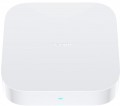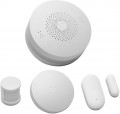Type
—
Alarm kit. A ready-to-install solution that includes all the necessary elements of the security system. Depending on the implementation, the standard set includes a central hub, sirens, motion and opening sensors for windows or doors, key fobs, etc. Less common are kits with household or fire sensors, for example, leakage or smoke sensors. The specific set of included elements must be specified for a particular set. In any case, in this form the security system is ready to work straight out of the box.
—
Hub (control unit). A central device that coordinates the operation of connected sensors and auxiliary systems. Most often, this is a hub for a “smart” home - all kinds of sensors (including security ones) are connected to it, and it also serves for flexible configuration of operating scenarios for the deployed smart system.
Communication protocol with sensors
This parameter directly affects the compatibility of additionally connected devices, including complete sensors. Such devices must have the same protocol, otherwise normal operation will be impossible. As for specific options, modern alarm kits can use both common
Wi-Fi and
Bluetooth standards, as well as specialized protocols - most often
Z-Wave,
Zigbee or
Jeweller. Here is a more detailed description of each of these standards:
— Wi-Fi. A technology used mainly for building wireless computer networks, and more recently — also for direct communication between individual devices. The 2.4 GHz or 5 GHz range is most often used for communication. In the case of wireless sensors, one of the advantages of Wi-Fi is that it is a generally accepted standard; due to this, many sensors with this type of communication can work without special equipment — they are able to connect to regular wireless routers or even individual devices such as laptops and tablets (some models even allow sending notifications via the Internet, through the same router). However, such versatility has a downside: Wi-Fi has no additional optimization for working with wireless sensors. As a result, such communication is inferior to specialized protocols in terms of overall reliability, special functionality and energy efficiency. So
...this type of communication is typical mainly for devices designed for simple conditions of use — such as climate temperature/humidity sensors for smart home systems.
— Bluetooth. Another common wireless communication standard. It operates in the 2.4 GHz range; unlike Wi-Fi, it is used only for direct communication between devices. It is also poorly suited for professional use (in particular, the response delay can reach 2-3 seconds), and therefore is mainly found in household-specific sensors designed for communication to smartphones/tablets or smart home systems. The Bluetooth LE protocol, supported by Bluetooth modules of version 4.0 and higher, is most often used for communication: it is specially designed for miniature devices with small capacity of built-in batteries, allows data transmission with very low energy costs and at the same time provides a range of up to 100 m.
— Z-Wave. A wireless communication standard specifically designed for automation and control systems, including alarms and smart homes. Along with the one described below, Zigbee is one of the generally accepted protocols used in such systems. Such communication is simple and inexpensive to implement, while being quite functional and practical. It provides for the transmission of the simplest and shortest control commands, which helps save energy, and operates in the range of up to 1 GHz, due to which it is not susceptible to interference from Wi-Fi and Bluetooth devices. In addition, in Z-Wave-based networks, it is possible to use a MESH-type topology - when each individual device is also a full-fledged repeater of signals from other components of the system. Devices in networks of this type can choose any signal route, through any number of intermediate nodes, depending on the situation. For example, if direct communication between two nodes for some reason turned out to be impossible, the data will be sent "bypassing" through other network devices, and the system will automatically determine the most optimal route. This makes it easy to organize large networks with a large number of devices and a large coverage area.
— Zigbee. Another communication protocol created for automation systems (including smart home), alarms, industrial control, etc. In many ways, it is similar to the Z-Wave described above: it allows you to transmit control signals with low energy costs, as well as create MESH networks with signal direction through several nodes and automatic selection of the optimal route taking into account the current situation in the network. The main differences between Zigbee and Z-Wave are high protection of communication channels from hacking, as well as the ability to ensure high response speed. The downside of these advantages is the higher cost of implementing this protocol. Therefore, there are slightly fewer devices for this communication standard than for Z-Wave.
— Jeweller. A proprietary communication protocol developed by Ajax Systems. The company specializes in alarms, and this protocol was originally created specifically for such systems — this is what determines its advanced characteristics. In particular, Jeweller provides a communication range of up to 2 km with very low energy costs, has high-class protection against hacking, allows you to change frequencies when trying to jam the operating range and supports the simultaneous communication of up to 150 devices per gateway. However, the main disadvantage of this protocol is that its use is limited to devices from one manufacturer. So it makes sense to purchase models with Jeweller support if the house uses (or plans to use) an alarm system from Ajax Systems.
— Own frequency. In the context of alarms and HUBs, this parameter refers to the own frequency at which wireless data exchange between the protection system links is ensured. Its specific value is determined by the device manufacturer, but the most common options are 433–434 MHz and 868 MHz. Using the own frequency improves the reliability and safety of the protection system, since it reduces the likelihood of interference from other wireless devices operating at close frequencies. When choosing based on this parameter, it is important to consider equipment compatibility, standards, and licensing requirements (in order to avoid potential violations of the law).Motion sensors
The number of motion sensors supplied with the central unit.
This number determines how many areas can be covered with the out-of-the-box kit without purchasing additional equipment. Motion sensors can have different coverage angles and response ranges (see below for all this), however, when choosing, you can proceed from the fact that one such device is usually enough for a living room or a medium-sized office space. Accordingly, the number of motion sensors approximately corresponds to the number of rooms for which the set is designed in the original configuration. It is usually small,
two or more sensors are extremely rare: it is assumed that, if necessary, it is easier to purchase additional sensors separately.
Opening sensors
Number of opening sensors supplied with the central unit.
This number corresponds to the number of doors that can be equipped with an alarm system using only this kit “out of the box”, without purchasing additional equipment. Note that opening sensors are rarely provided in the kit
more than one : this allows the user to buy the alarm kit they like without fear of overpaying for extra equipment, and if more sensors are needed, they can be purchased separately. In addition, some sets are
not equipped with such sensors at all.
Siren
The presence of its own siren in the standard configuration of the set.
The siren provides an audible and, in some models, a light alarm; sometimes this is enough to stop an encroachment on a protected object or to attract the attention of security / law enforcement officers. Such equipment can also be purchased separately (if there is a corresponding output, see "Control panel options"). However, in most cases it is more convenient to buy a system that was originally equipped with a siren: this will allow you not to worry about compatibility, and complete sirens usually give out more than a decent number of decibels (see "Siren volume").
Motion sensor
Model of the motion sensor(s) supplied with the alarm.
The main data on the motion sensor — coverage angles, range — are usually given in the characteristics of the kit (for more details about this data, see below). However, knowing the name of the model, you can find more detailed information about it — up to practical reviews. In addition, the model name will be useful when looking for spare or additional sensors, in addition to the complete ones.
Opening sensor
Model of the opening sensor(s) supplied with the alarm.
The operating characteristics of the opening sensor — primarily the threshold (see below) — are usually given in the general specifications of the kit. However, some may need more detailed information — to find it, the name of the model will come in handy. In addition, it is useful to know this name if there are not enough complete sensors and they are supposed to be purchased additionally: instead of searching and selecting compatible components, it is enough to purchase sensors of the same type.
Horizontal angle of coverage
The angle covered by the complete horizontal motion sensor(s).
This parameter allows you to evaluate the space that falls into the field of view of the device. The larger the coverage angle, the smaller the size of the “dead zone” that does not fall into the field of view of the sensor. A wide field of view is especially important if there is a large space on the sides of the sensor: the farther from the device, the wider the “dead zone”. However, in the most advanced models, this angle is 180 ° — this means that the sensor suspended on the wall will horizontally cover the entire space in front of the wall.
Motion sensor range
The range of a motion sensor is the maximum distance at which it can detect motion.
If there is only one sensor in the room, then its range of action should not be less than the diagonal length of the room. Large spaces that are not covered by a single sensor can be covered with multiple sensors. It is also worth noting that the range claimed in the characteristics is a rather approximate parameter and is usually indicated for perfect conditions; therefore, it is worth choosing according to this characteristic with a certain margin (at least 10 – 15%).

